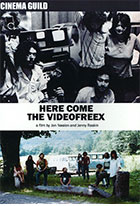
Here Come the Videofreex 2015
Distributed by Cinema Guild, 115 West 30th Street, Suite 800, New York, NY 10001; 212-685-6242
Directed by Jon Nealon and Jenny Raskin
DVD , color and b&w, 78 min.
General Adult
Activism, History, Journalism, Mass Media, Photography, Protest Movements, Social Movements, Technology, U.S. History
Date Entered: 10/18/2016
Reviewed by Linda Frederiksen, Washington State University, Vancouver, WAWith smart phones and social media, sharing video recording is now a ubiquitous feature of current culture. It was not always the case. In the late 1960s, all televised access to news and current events came through the three major television networks: ABC, CBS, and NBC. Cameras were large, bulky, and immobile and the 16mm film used to capture images was laboriously edited and transferred for viewing. That model changed in 1967 when Sony introduced and sold to the consumer market the first portable video recording system.
Coinciding with a period of political and social upheaval, the potential of the Sony DV-2400 Video Rover Portapak, and others like it was quickly recognized by young artists and political activists as an alternate means of communication. Video collectives of ‘dirty hippies’ formed to document and make available information by and about an increasingly vocal and critical counterculture. This fascinating documentary follows members of the Videofreex, one of the first video collectives, from its formation in 1969 through experiments in pirate television in upper state New York in the early 1970s.
Based on thousands of hours of footage from the Videofreex Archives, the film tells the story not only of the collective, but also a disruptive piece of technology and the social upheaval of the times. Never before seen interviews with cultural icons such as Black Panther leader Fred Hampton and anarchist Abbie Hoffman are combined with scenes of the 1969 Woodstock music festival, early women’s liberation protests, and public service announcements. Although the technical quality of the archival film is poor by today’s standards, the immediacy of a particular moment in time as it was captured on videotape is exceptional. Highly recommended for film and media studies courses.